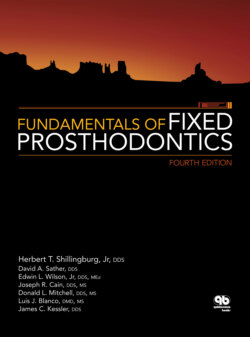Читать книгу Fundamentals of Fixed Prosthodontics - James C. Kessler - Страница 64
Facebow record technique
ОглавлениеTwo horseshoe wax wafers (Surgident Coprwax Bite Wafer, Heraeus Kulzer) are heated in warm tap water until they become soft and flexible. A wafer is adapted to each side of the bite fork so that it is uniformly covered (Fig 5-2). The wax-covered bite fork is placed against the maxillary teeth. The attachment portion of the fork is centered on the patient’s midline. The bite fork is supported, and the patient is instructed to close lightly into the wax to obtain shallow impressions of only the cusp tips (Fig 5-3). The wax is cooled, and the bite fork is removed from the mouth. Excess wax is trimmed away. Any areas where soft tissue was registered on the wax must be completely removed.
Fig 5-2 A wax wafer has been adapted to each side of the bite fork.
Fig 5-3 The bite fork is placed against the maxillary teeth and supported by the dentist as the patient closes lightly for a shallow impression of the cusp tips.
Fig 5-4 The patient guides the earpieces (a) as the dentist places them into the external auditory meati (b).
The maxillary cast is set in the bite fork registration to confirm that the cast seats firmly in the index with no rocking or instability. If the cast does not seat, first the occlusal surfaces of the cast are checked to make sure there are no nodules of stone. If there are none, then either the registration or the cast is distorted and should be remade.
The bite fork is placed back in the mouth, and the patient is instructed to close to hold it securely between the maxillary and mandibular arches. The patient is then asked to grasp both arms of the facebow and guide the plastic earpieces into the external auditory meati, much as one would guide the earpieces of a stethoscope (Fig 5-4). The shaft of the nasion relator is extended while the facebow is adjusted up or down to center the plastic nosepiece on the patient’s nasion, and the thumbscrew is tightened (Fig 5-5). Next, the thumbscrew is tightened on the top of the facebow (Fig 5-6).
The Quick Lock Toggle is slipped into the slot on the bite fork with the head of the thumbscrew facing downward, and the screw is tightened (Fig 5-7). The Quick Lock Toggle is stabilized, and the T screw is tightened (Fig 5-8). The facebow record is now complete (Fig 5-9).
Fig 5-5 The shaft of the nasion relator is extended, and the thumbscrew is tightened.
Fig 5-6 The thumbscrew on the top of the facebow is tightened.
Fig 5-7 The Quick Lock Toggle is slipped into the slot on the bite fork (a), and the thumbscrew is tightened (b).
Fig 5-8 The Quick Lock Toggle is stabilized, and the T screw is tightened.
Fig 5-9 Completed facebow record.
Fig 5-10 The thumbscrew is loosened, and the nasion relator is withdrawn.
Fig 5-11 The thumbscrew on the top of the facebow is loosened.
Fig 5-12 The patient is instructed to open, and the facebow record is removed.
Fig 5-13 The space between the facebow and the bite fork is checked for uniformity.
The thumbscrew is loosened, and the plastic nasion relator is withdrawn (Fig 5-10). Then the thumbscrew on the top surface of the facebow is loosened by a quarter turn (Fig 5-11). As the patient slowly opens the mouth, the entire assembly is carefully removed from the head (Fig 5-12). The T screw is rechecked and securely tightened while the Quick Lock Toggle is stabilized. It is sometimes difficult to adequately tighten the T screw while the facebow is on the patient’s head. It is confirmed that the bite fork is evenly spaced inside the facebow (Fig 5-13). The transfer assembly is removed from the facebow, and the support bar is reinstalled (Fig 5-14). The bite fork is rinsed with running tap water, and the plastic earpieces, the facebow assembly, and the bite fork (Fig 5-15) are disinfected with a hospital-grade disinfectant. The transfer assembly and bite fork are stored in an unsealed sterilization bag until it is time to mount the maxillary cast (Fig 5-16).
Fig 5-14 The transfer assembly is removed from the facebow (a), and the support bar is placed in position (b).
Fig 5-15 The bite fork is rinsed with running water (a) and sprayed with disinfectant (b).
Fig 5-16 The transfer assembly and attached bite fork are stored in an open sterilization bag.
Fig 5-17 The immediate lateral translation guide is moved to zero on each condylar guide.
Fig 5-18 The transfer base is placed on the articulator (a) and stabilized with a metal mounting disk (b).
Fig 5-19 (a) The vertical shaft of the transfer assembly is placed in the transfer assembly. (b) After tightening the clamp screw.
